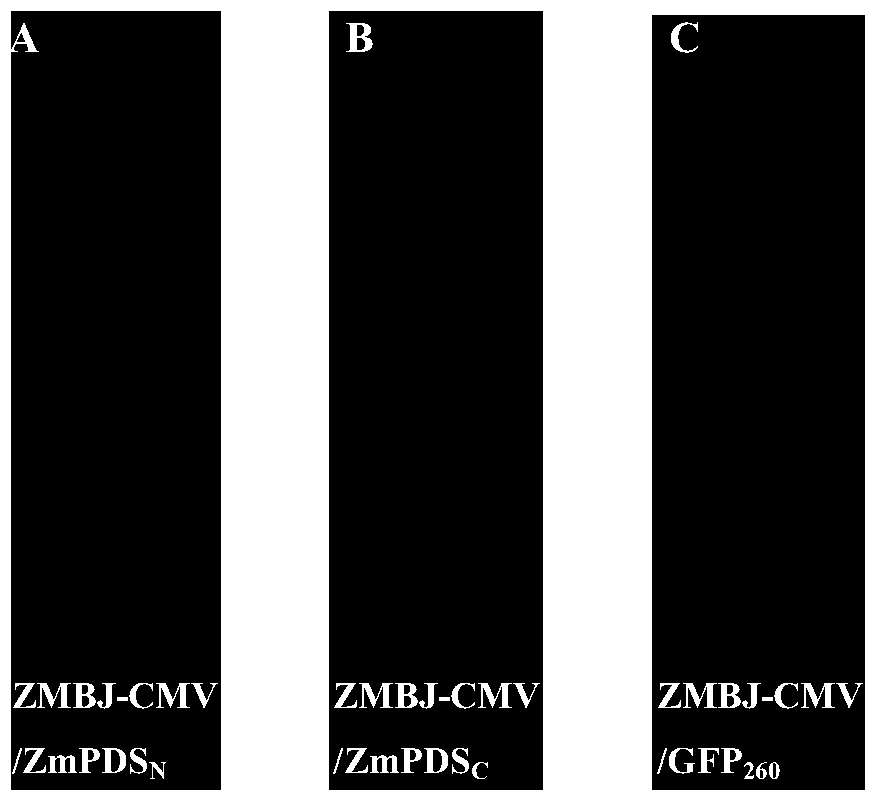Cucumber mosaic virus-induced gene silencing system and its application
A technology of cucumber mosaic virus and gene silencing, applied in the field of plant genetic engineering, can solve the problems of unsuccessful application of corn and no CMV, etc., and achieve the effect of simple method and wide range of hosts
- Summary
- Abstract
- Description
- Claims
- Application Information
AI Technical Summary
Problems solved by technology
Method used
Image
Examples
Embodiment 1
[0029] Example 1 Construction of CMV-ZMBJ invasive cDNA clone
[0030] In this example, firstly, the CMV-ZMBJ isolate, which was firstly isolated from natural infecting corn in my country’s corn production fields, was used as the material to construct an invasive cDNA clone of CMV-ZMBJ, and the skeleton vector for constructing the invasive clone was pCass-Rz .
[0031] The specific implementation method is as follows:
[0032] (1) Extract the virus particles of CMV-ZMBJ expanded in Nicotiana occidentalis, all operations are performed at 0-4°C or on ice;
[0033] a. Put the infected tissue, pre-cooled buffer A (5mM EDTA; 0.5M trisodium citrate, citric acid to adjust pH 6.5-7.0; add 0.5% thioglycolic acid before use) and chloroform in a pre-cooled mixer press 1g : 2ml: 2ml ratio mixing;
[0034] b. Centrifuge these mixtures in a large polypropylene tube, 4°C, 10,000 rpm, 15 min;
[0035] c. Remove the water layer and filter through a layer of pre-moistened (water-moistened) filter cloth (...
Embodiment 2
[0101] Example 2pCMV201-2b N81 -Construction of A vector
[0102] F1-I and R1-A amplify the 1844-2658nt upstream fragment of CMV-ZMBJ RNA2. F2-A and CMV23R-BamHI amplify the downstream fragment of CMV-ZMBJ RNA2 (2753-3054nt). Both the 3'end of the upstream fragment and the 5'end of the downstream fragment are introduced by primers with multiple cloning sites (5'-GGTACCTTGAGCTAGCAGGCCTCTAGA-3') so that the upstream and downstream fragments can be fused together by fusion PCR. In this way, the RNA22659-2752nt region was replaced with multiple cloning sites. The fusion PCR product was ligated back to pCMV201 through Nco I at 1847bp and BamH I at the 3'end.
[0103] The modified pCMV201 was named pCMV2-2b N81 -A (plasmid map such as figure 1 (Shown), the multiple cloning site is used to insert foreign gene fragments, together with pCMV101 and pCMV301 to form a CMV-ZMBJ VIGS vector.
[0104] Table 2 pCMV201-2b N81 -Primer used for vector construction
[0105]
[0106] Note: The italics ...
Embodiment 3
[0107] Example 3pCMV201-2b N81 -A: Construction of gene fragment vector to be studied and Agrobacterium infiltration
[0108] (1)pCMV201-2b N81 -A: Construction of NbPDS vector
[0109] Using Benshengyan cDNA as template, the target fragment NbPDS (NbPDS gene ORF467-764bp, 288bp) was obtained by PCR amplification with primer pair NbPDSf and Nb-PDSr, and NbPDS was cloned into pCMV2-2b using Kpn I and Xba I N81 -PCMV2-2b is obtained from the A vector N81 -A: NbPDS, verified by sequencing. PCMV2-2b with inserted 260bp GFP fragment N81 -A(pCMV2-2b N81 -A: GFP 260 ) As a negative control.
[0110] (2)pCMV201-2b N81 -A: Construction of ZmPDS vector
[0111] Using the cDNA of B73 corn as a template, the target fragment ZmPDS was amplified by PCR using primer pairs ZmPDS1191F and ZmPDSR2, ZmPDS1415F and ZmPDS1665R, respectively N (ZmPDS gene ORF1191-1424bp, 234bp) and ZmPDS C (ZmPDS gene ORF1415-1665bp, 250bp), then use Kpn I and Xba I to separate ZmPDS N And ZmPDS C Clone to pCMV2-2b N81 -A ...
PUM
 Login to View More
Login to View More Abstract
Description
Claims
Application Information
 Login to View More
Login to View More - R&D
- Intellectual Property
- Life Sciences
- Materials
- Tech Scout
- Unparalleled Data Quality
- Higher Quality Content
- 60% Fewer Hallucinations
Browse by: Latest US Patents, China's latest patents, Technical Efficacy Thesaurus, Application Domain, Technology Topic, Popular Technical Reports.
© 2025 PatSnap. All rights reserved.Legal|Privacy policy|Modern Slavery Act Transparency Statement|Sitemap|About US| Contact US: help@patsnap.com



